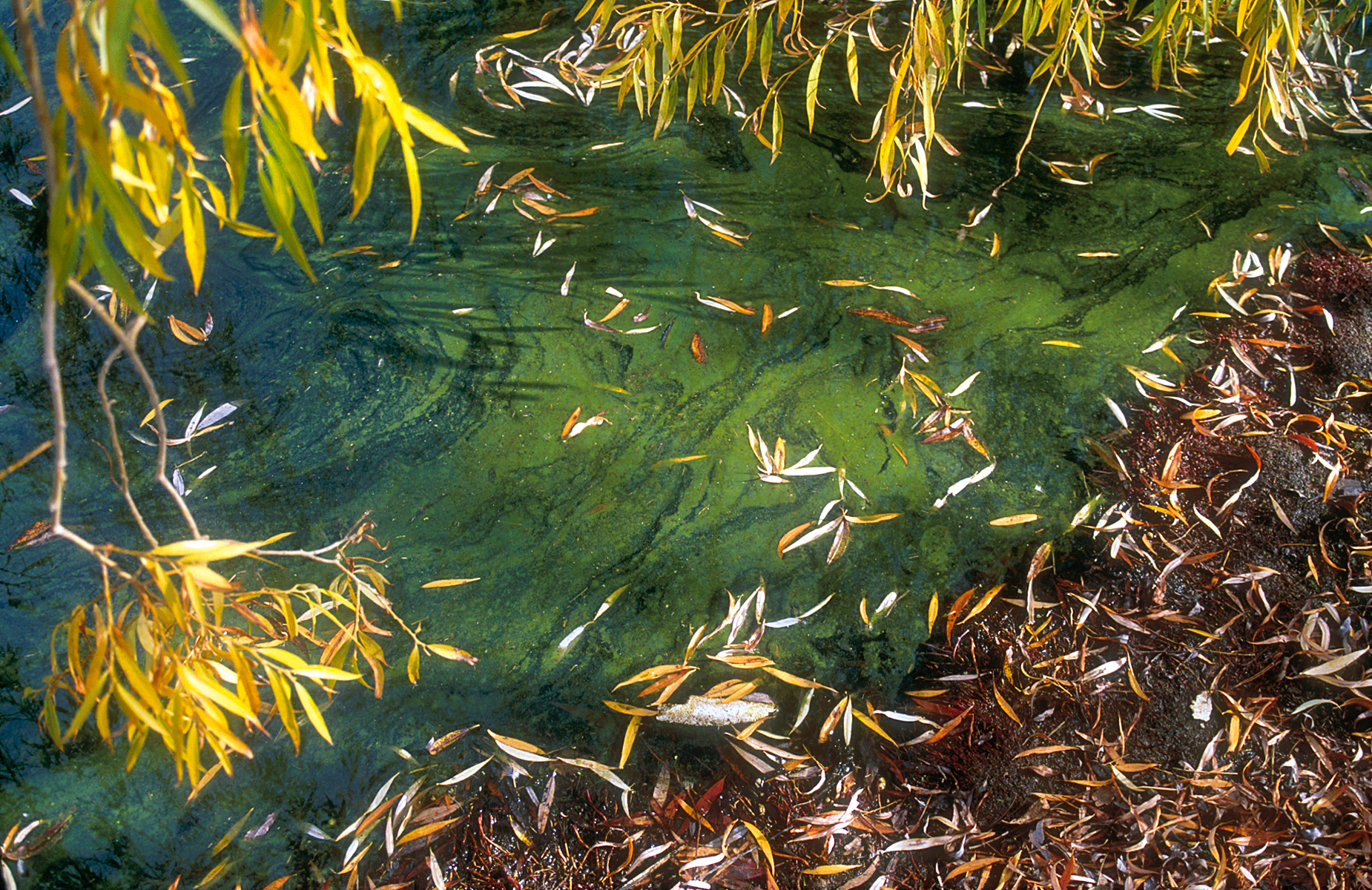Blue-green algae are actually types of bacteria known as Cyanobacteria. They normally look green and sometimes may turn bluish when scums are dying.
Taste and odour problems commonly occur with large concentrations of blue-green algae and some species are capable of producing toxins.

Blue-green algal blooms
'Bloom' is the term used to describe an accumulation of algal cells to a point where they discolour the water, form scums, produce unpleasant tastes and odours, affect fish populations and reduce the water quality. Decomposing algae can also cause depletion of oxygen and induce fish kills.
Species of blue-green algae may dominate and increase excessively in water when:
- nutrient levels, particularly phosphorus and nitrogen are sufficient to support the population growth
- the ratio of nitrogen to phosphorous concentration is low
- water is still and turbulence is low (lack of mixing)
- weather patterns are stable for a week or so
- weather is warm (although blooms can occur in cooler weather too).
Blue-green algal blooms often persist for several weeks, sometimes months, depending mainly on the weather or flow conditions. Cooler, windy weather or increased flow may reduce or prevent blooms from occurring.
As the bloom dies, the cells tend to become 'leaky'. If the bloom contains species that produce toxins, it will result in the release of toxins into the surrounding water. Once released, some toxins may persist for more than three months before they degrade.
Problems with blue-green algae
A number of environmental conditions need to be in place for an algal bloom to occur. These include sunlight, nutrients as well as weather and flow conditions that lead to separation of the water into layers, usually with a layer of warm surface water which does not mix with a colder deeper layer.
Blue-green algae thrives in the warm surface layer of a water body that forms, usually, from spring through to autumn throughout Australia's inland waters. Blue-green algae possess gas pockets which prevent them from sinking so that they remain in the surface layer and can access the abundant light near the water surface, leading to rapid growth.
Potential risks
If blue-green algae multiply to high numbers, toxins may be produced causing health problems for people, domestic animals and stock that come into contact with the algae.
Contact with the algae by recreational users can be harmful. There have been reports of skin and eye irritations, nausea, vomiting, muscle weakness or cramps by some people who have swum through algal scum or swallowed it.
Blue-green algae blooms can cause:
- harmful human health effects
- death of livestock
- domestic animals and wildlife
- bad odours
- fish kills
- closure of water storages for drinking or recreational use
- higher water treatment costs.
Blue-green algae are actually types of bacteria known as Cyanobacteria. They normally look green and sometimes may turn bluish when scums are dying.
Taste and odour problems commonly occur with large concentrations of blue-green algae and some species are capable of producing toxins.
Blue-green algal blooms
'Bloom' is the term used to describe an accumulation of algal cells to a point where they discolour the water, form scums, produce unpleasant tastes and odours, affect fish populations and reduce the water quality. Decomposing algae can also cause depletion of oxygen and induce fish kills.
Species of blue-green algae may dominate and increase excessively in water when:
- nutrient levels, particularly phosphorus and nitrogen are sufficient to support the population growth
- the ratio of nitrogen to phosphorous concentration is low
- water is still and turbulence is low (lack of mixing)
- weather patterns are stable for a week or so
- weather is warm (although blooms can occur in cooler weather too).
Blue-green algal blooms often persist for several weeks, sometimes months, depending mainly on the weather or flow conditions. Cooler, windy weather or increased flow may reduce or prevent blooms from occurring.
As the bloom dies, the cells tend to become 'leaky'. If the bloom contains species that produce toxins, it will result in the release of toxins into the surrounding water. Once released, some toxins may persist for more than three months before they degrade.
Problems with blue-green algae
A number of environmental conditions need to be in place for an algal bloom to occur. These include sunlight, nutrients as well as weather and flow conditions that lead to separation of the water into layers, usually with a layer of warm surface water which does not mix with a colder deeper layer.
Blue-green algae thrives in the warm surface layer of a water body that forms, usually, from spring through to autumn throughout Australia's inland waters. Blue-green algae possess gas pockets which prevent them from sinking so that they remain in the surface layer and can access the abundant light near the water surface, leading to rapid growth.
Potential risks
If blue-green algae multiply to high numbers, toxins may be produced causing health problems for people, domestic animals and stock that come into contact with the algae.
Contact with the algae by recreational users can be harmful. There have been reports of skin and eye irritations, nausea, vomiting, muscle weakness or cramps by some people who have swum through algal scum or swallowed it.
Blue-green algae blooms can cause:
- harmful human health effects
- death of livestock
- domestic animals and wildlife
- bad odours
- fish kills
- closure of water storages for drinking or recreational use
- higher water treatment costs.
